West Valley Team - I was invited to join in on the fun at the West Valley Middle School Winter Celebration this afternoon. I had invitations from Rylan Sali, Betsaida Larios, and Johnny Bolles to join in the fun at the 400 Pack at WVMS. I had a great time going around to the different displays on Winter Celebrations Around the World. Teachers Ms. Olden and Ms. Schmidt were outstanding as they organized the kids into different themes from different countries. And, of course, there was even food from the countries on display! Here are some of the highlights from the event:
These girls are displaying Three Kings Day along with refreshments.
This is the display on Christmas - celebrated in the United States and Canada.
These guys shared a display on Diwali, as well as having some donut-like snacks.
These girls shared a display on Posadas, which is celebrated in Mexico.
Regardless of how you celebrate, I want each and every one of you on the West Valley School District Team to have an outstanding Winter Break! Have a wonderful Holiday Season, and tremendous New Year! It is amazing to think that it will be 2020 when we return in January! I know that with our team, 2020 will be just as awesome as 2019 has been! Enjoy! Mike
Thursday, December 19, 2019
Tuesday, December 17, 2019
Opportunities for Choice - A Key Ingredient for Personalized Learning
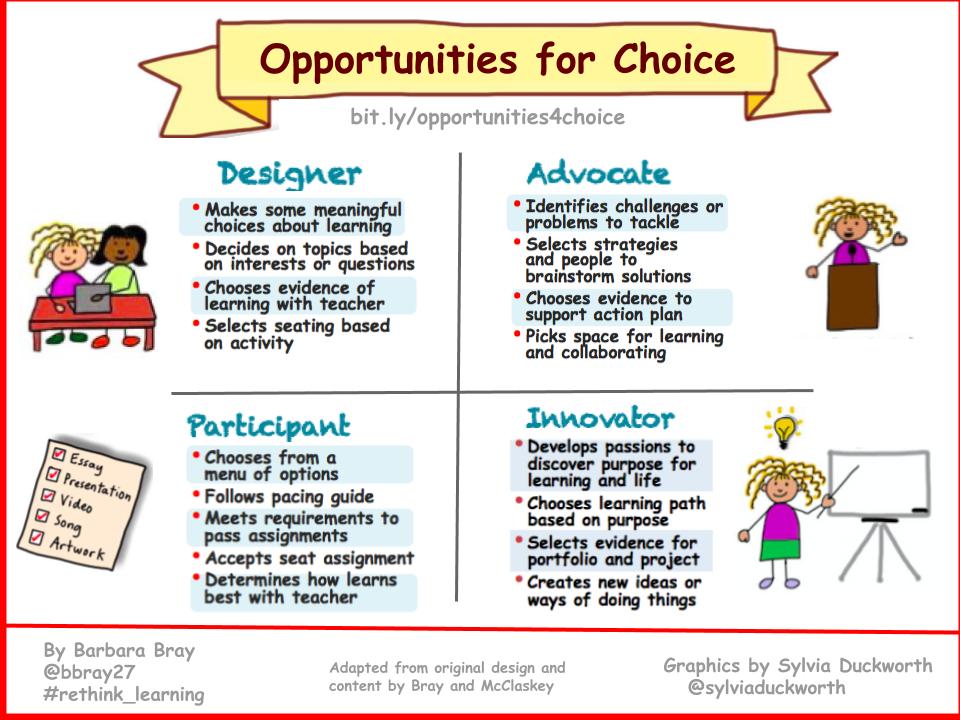 Changing teaching and learning can be daunting. The idea of meeting all students where they are means redesigning the system and how we teach. That also means understanding and meeting our students where they are. It is about changing the concept of being a “teacher” to becoming more of a researcher, designer, diagnostician and expert facilitator of constructive learning experiences. [CompetencyWorks 2018]
After reading the paper from iNACOL, “Meeting All Students Where They Are,” I realized I needed to bring in new concepts to address choice. It is not a continuum of choice. It is about providing opportunities for choice at different levels. It depends on where the learners are around tackling a task if the environment provides multiple opportunities, and how empowered students are to take responsibility for the choices they make.
Teachers may only know what they know or learned as students themselves. Many teachers believe that providing a set of pre-planned choices from a computer program or a list of options was enough to give students opportunities for choice. I see so many teachers working way too hard to create opportunities for students to choose the best way to learn. The idea of developing opportunities for choice is to start turning over the learning so students learn best by being the ones working harder than the teachers.
I believe that any learner any age can have opportunities for choice inside and outside of school. Educators reached out to me to let me know they were concerned about choice being on a continuum. They mentioned that some learners were ready to advocate around something they were passionate about, and, at the same time, were also at the participant level when preparing for a test or taking notes.
Changing teaching and learning can be daunting. The idea of meeting all students where they are means redesigning the system and how we teach. That also means understanding and meeting our students where they are. It is about changing the concept of being a “teacher” to becoming more of a researcher, designer, diagnostician and expert facilitator of constructive learning experiences. [CompetencyWorks 2018]
After reading the paper from iNACOL, “Meeting All Students Where They Are,” I realized I needed to bring in new concepts to address choice. It is not a continuum of choice. It is about providing opportunities for choice at different levels. It depends on where the learners are around tackling a task if the environment provides multiple opportunities, and how empowered students are to take responsibility for the choices they make.
Teachers may only know what they know or learned as students themselves. Many teachers believe that providing a set of pre-planned choices from a computer program or a list of options was enough to give students opportunities for choice. I see so many teachers working way too hard to create opportunities for students to choose the best way to learn. The idea of developing opportunities for choice is to start turning over the learning so students learn best by being the ones working harder than the teachers.
I believe that any learner any age can have opportunities for choice inside and outside of school. Educators reached out to me to let me know they were concerned about choice being on a continuum. They mentioned that some learners were ready to advocate around something they were passionate about, and, at the same time, were also at the participant level when preparing for a test or taking notes.

Changing teaching and learning can be daunting. The idea of meeting all students where they are means redesigning the system and how we teach. That also means understanding and meeting our students where they are. It is about changing the concept of being a “teacher” to becoming more of a researcher, designer, diagnostician and expert facilitator of constructive learning experiences. [CompetencyWorks 2018]
After reading the paper from iNACOL, “Meeting All Students Where They Are,” I realized I needed to bring in new concepts to address choice. It is not a continuum of choice. It is about providing opportunities for choice at different levels. It depends on where the learners are around tackling a task if the environment provides multiple opportunities, and how empowered students are to take responsibility for the choices they make.
Teachers may only know what they know or learned as students themselves. Many teachers believe that providing a set of pre-planned choices from a computer program or a list of options was enough to give students opportunities for choice. I see so many teachers working way too hard to create opportunities for students to choose the best way to learn. The idea of developing opportunities for choice is to start turning over the learning so students learn best by being the ones working harder than the teachers.
I believe that any learner any age can have opportunities for choice inside and outside of school. Educators reached out to me to let me know they were concerned about choice being on a continuum. They mentioned that some learners were ready to advocate around something they were passionate about, and, at the same time, were also at the participant level when preparing for a test or taking notes.
Participant
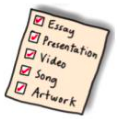 At the Participant level, students of any age may be more comfortable following instructions, step-by-step directions, or a pacing guide. Students as participants comply with what is required to pass assignments, get grades, or to prepare for graduation. Yet, learners of any age can be at the participant level when they may be uncomfortable or not confident in what they know, how they feel about themselves, or what they can or cannot do.
This is where teachers can refer to Lev Vygotsky’s Zone of Proximal Development (ZPD) as the More Knowledgeable Other (MKO). Vygotsky believed that mental tools extend our mental abilities enabling us to solve problems and create solutions in the real world. This means that to successfully function in school and beyond, children need to learn more than a set of facts and skills. They need to master a set of mental tools—tools of the mind to be able to choose the most appropriate tools, resources, and strategies that support their learning.
Teachers can do this by providing a menu of options for students and empathy as students take risks and make mistakes with the choices they make. These opportunities for choice can be in the form of images, videos, text-based resources, audio, hands-on activities, or interactions with peers. The choices available can also provide opportunities to showcase what they know from writing a paper to creating a performance.
At the Participant level, students of any age may be more comfortable following instructions, step-by-step directions, or a pacing guide. Students as participants comply with what is required to pass assignments, get grades, or to prepare for graduation. Yet, learners of any age can be at the participant level when they may be uncomfortable or not confident in what they know, how they feel about themselves, or what they can or cannot do.
This is where teachers can refer to Lev Vygotsky’s Zone of Proximal Development (ZPD) as the More Knowledgeable Other (MKO). Vygotsky believed that mental tools extend our mental abilities enabling us to solve problems and create solutions in the real world. This means that to successfully function in school and beyond, children need to learn more than a set of facts and skills. They need to master a set of mental tools—tools of the mind to be able to choose the most appropriate tools, resources, and strategies that support their learning.
Teachers can do this by providing a menu of options for students and empathy as students take risks and make mistakes with the choices they make. These opportunities for choice can be in the form of images, videos, text-based resources, audio, hands-on activities, or interactions with peers. The choices available can also provide opportunities to showcase what they know from writing a paper to creating a performance.
 At the Participant level, students of any age may be more comfortable following instructions, step-by-step directions, or a pacing guide. Students as participants comply with what is required to pass assignments, get grades, or to prepare for graduation. Yet, learners of any age can be at the participant level when they may be uncomfortable or not confident in what they know, how they feel about themselves, or what they can or cannot do.
At the Participant level, students of any age may be more comfortable following instructions, step-by-step directions, or a pacing guide. Students as participants comply with what is required to pass assignments, get grades, or to prepare for graduation. Yet, learners of any age can be at the participant level when they may be uncomfortable or not confident in what they know, how they feel about themselves, or what they can or cannot do.
This is where teachers can refer to Lev Vygotsky’s Zone of Proximal Development (ZPD) as the More Knowledgeable Other (MKO). Vygotsky believed that mental tools extend our mental abilities enabling us to solve problems and create solutions in the real world. This means that to successfully function in school and beyond, children need to learn more than a set of facts and skills. They need to master a set of mental tools—tools of the mind to be able to choose the most appropriate tools, resources, and strategies that support their learning.
Teachers can do this by providing a menu of options for students and empathy as students take risks and make mistakes with the choices they make. These opportunities for choice can be in the form of images, videos, text-based resources, audio, hands-on activities, or interactions with peers. The choices available can also provide opportunities to showcase what they know from writing a paper to creating a performance.
Designer
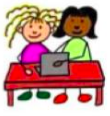 At the Designer level, students are starting to make some meaningful choices about their learning. The teacher provides learning opportunities and then gets out of the way for students to go on their own journey (via Jackie Gerstein). The teacher invites input from students to decide on topics based on interests or questions around content areas they are studying. The teacher collaborates with students to brainstorm ideas for lesson design, assessment strategies, and types of tools and resources to use with the activities. The teacher and students review and collaborate on how to give more choices as they learn. The teacher is also inviting their input on the redesign of the learning environment so they can select seating based on the activity. Students then choose and demonstrate evidence of learning with the teacher.
Advocate
At the Designer level, students are starting to make some meaningful choices about their learning. The teacher provides learning opportunities and then gets out of the way for students to go on their own journey (via Jackie Gerstein). The teacher invites input from students to decide on topics based on interests or questions around content areas they are studying. The teacher collaborates with students to brainstorm ideas for lesson design, assessment strategies, and types of tools and resources to use with the activities. The teacher and students review and collaborate on how to give more choices as they learn. The teacher is also inviting their input on the redesign of the learning environment so they can select seating based on the activity. Students then choose and demonstrate evidence of learning with the teacher.
Advocate
 At the Designer level, students are starting to make some meaningful choices about their learning. The teacher provides learning opportunities and then gets out of the way for students to go on their own journey (via Jackie Gerstein). The teacher invites input from students to decide on topics based on interests or questions around content areas they are studying. The teacher collaborates with students to brainstorm ideas for lesson design, assessment strategies, and types of tools and resources to use with the activities. The teacher and students review and collaborate on how to give more choices as they learn. The teacher is also inviting their input on the redesign of the learning environment so they can select seating based on the activity. Students then choose and demonstrate evidence of learning with the teacher.
At the Designer level, students are starting to make some meaningful choices about their learning. The teacher provides learning opportunities and then gets out of the way for students to go on their own journey (via Jackie Gerstein). The teacher invites input from students to decide on topics based on interests or questions around content areas they are studying. The teacher collaborates with students to brainstorm ideas for lesson design, assessment strategies, and types of tools and resources to use with the activities. The teacher and students review and collaborate on how to give more choices as they learn. The teacher is also inviting their input on the redesign of the learning environment so they can select seating based on the activity. Students then choose and demonstrate evidence of learning with the teacher.
Advocate
 At the Advocate level, students are beginning to be validated as “learners” who believe they can own and drive their learning. This is where students as learners identify challenges or problems that they want to address, research, and tackle. When they identify and take on a challenge or problem, they then own an authentic voice with a clear purpose for the choices they will make to advocate for what they believe. They are empowered to develop strategies to solve the problem and may even build a network with others who want to solve the challenge or problem with them. Learners choose different spaces for learning and collaborating. They reach out to experts and others in and outside of school to support their research. Learners may work strategically individually or with a group to develop an action plan to shape the change. They do the research and find the appropriate evidence to support the action plan. When learners experience advocacy working toward something they believe in, they begin to understand their part in how they can make change happen.
Innovator
At the Advocate level, students are beginning to be validated as “learners” who believe they can own and drive their learning. This is where students as learners identify challenges or problems that they want to address, research, and tackle. When they identify and take on a challenge or problem, they then own an authentic voice with a clear purpose for the choices they will make to advocate for what they believe. They are empowered to develop strategies to solve the problem and may even build a network with others who want to solve the challenge or problem with them. Learners choose different spaces for learning and collaborating. They reach out to experts and others in and outside of school to support their research. Learners may work strategically individually or with a group to develop an action plan to shape the change. They do the research and find the appropriate evidence to support the action plan. When learners experience advocacy working toward something they believe in, they begin to understand their part in how they can make change happen.
Innovator
 At the Advocate level, students are beginning to be validated as “learners” who believe they can own and drive their learning. This is where students as learners identify challenges or problems that they want to address, research, and tackle. When they identify and take on a challenge or problem, they then own an authentic voice with a clear purpose for the choices they will make to advocate for what they believe. They are empowered to develop strategies to solve the problem and may even build a network with others who want to solve the challenge or problem with them. Learners choose different spaces for learning and collaborating. They reach out to experts and others in and outside of school to support their research. Learners may work strategically individually or with a group to develop an action plan to shape the change. They do the research and find the appropriate evidence to support the action plan. When learners experience advocacy working toward something they believe in, they begin to understand their part in how they can make change happen.
At the Advocate level, students are beginning to be validated as “learners” who believe they can own and drive their learning. This is where students as learners identify challenges or problems that they want to address, research, and tackle. When they identify and take on a challenge or problem, they then own an authentic voice with a clear purpose for the choices they will make to advocate for what they believe. They are empowered to develop strategies to solve the problem and may even build a network with others who want to solve the challenge or problem with them. Learners choose different spaces for learning and collaborating. They reach out to experts and others in and outside of school to support their research. Learners may work strategically individually or with a group to develop an action plan to shape the change. They do the research and find the appropriate evidence to support the action plan. When learners experience advocacy working toward something they believe in, they begin to understand their part in how they can make change happen.
Innovator
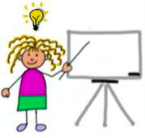 At the Innovator level, learners use their strengths and interests to explore what could be their passion for learning. When they find their passion, they can then discover their purpose for learning and life. Learners can then choose their learning path based on that purpose. Being at the Innovator level can happen at any age and learners can realize that their passion and purpose may change often throughout their lives. They may want to learn a new language, create a product, solve a problem, or design something new.
Learners can be part of a pathways program to guide the design of their learning. They can find an advisor or mentor who can guide them as they explore their interests, talents, and passions to discover their purpose. They can choose extended learning opportunities such as internships or apprenticeship to take their aspirations to another level. Learners can also be innovators by doing a “Capstone” or “Passion” Project that they work on throughout the year and then present as a culminating activity. As part of the project, they select evidence of learning for their portfolio and final presentation. Being an innovator includes attributes of an entrepreneur as someone who creates new ideas or ways of doing things.
The goal of providing more choice is to move from being participants of learning to become self-directed, independent learners with agency. It is about teachers and learners changing mindsets and having “can do” attitudes. This takes time and a process for both teachers and learners. When you acquire the skills needed for advocacy and innovation, learners automatically take more responsibility for their learning. The more choices learners make on their own will give them the skills to advocate for what they are passionate about and become more innovative about how they discover their purpose for learning.
At the Innovator level, learners use their strengths and interests to explore what could be their passion for learning. When they find their passion, they can then discover their purpose for learning and life. Learners can then choose their learning path based on that purpose. Being at the Innovator level can happen at any age and learners can realize that their passion and purpose may change often throughout their lives. They may want to learn a new language, create a product, solve a problem, or design something new.
Learners can be part of a pathways program to guide the design of their learning. They can find an advisor or mentor who can guide them as they explore their interests, talents, and passions to discover their purpose. They can choose extended learning opportunities such as internships or apprenticeship to take their aspirations to another level. Learners can also be innovators by doing a “Capstone” or “Passion” Project that they work on throughout the year and then present as a culminating activity. As part of the project, they select evidence of learning for their portfolio and final presentation. Being an innovator includes attributes of an entrepreneur as someone who creates new ideas or ways of doing things.
The goal of providing more choice is to move from being participants of learning to become self-directed, independent learners with agency. It is about teachers and learners changing mindsets and having “can do” attitudes. This takes time and a process for both teachers and learners. When you acquire the skills needed for advocacy and innovation, learners automatically take more responsibility for their learning. The more choices learners make on their own will give them the skills to advocate for what they are passionate about and become more innovative about how they discover their purpose for learning.
 At the Innovator level, learners use their strengths and interests to explore what could be their passion for learning. When they find their passion, they can then discover their purpose for learning and life. Learners can then choose their learning path based on that purpose. Being at the Innovator level can happen at any age and learners can realize that their passion and purpose may change often throughout their lives. They may want to learn a new language, create a product, solve a problem, or design something new.
At the Innovator level, learners use their strengths and interests to explore what could be their passion for learning. When they find their passion, they can then discover their purpose for learning and life. Learners can then choose their learning path based on that purpose. Being at the Innovator level can happen at any age and learners can realize that their passion and purpose may change often throughout their lives. They may want to learn a new language, create a product, solve a problem, or design something new.
Learners can be part of a pathways program to guide the design of their learning. They can find an advisor or mentor who can guide them as they explore their interests, talents, and passions to discover their purpose. They can choose extended learning opportunities such as internships or apprenticeship to take their aspirations to another level. Learners can also be innovators by doing a “Capstone” or “Passion” Project that they work on throughout the year and then present as a culminating activity. As part of the project, they select evidence of learning for their portfolio and final presentation. Being an innovator includes attributes of an entrepreneur as someone who creates new ideas or ways of doing things.
The goal of providing more choice is to move from being participants of learning to become self-directed, independent learners with agency. It is about teachers and learners changing mindsets and having “can do” attitudes. This takes time and a process for both teachers and learners. When you acquire the skills needed for advocacy and innovation, learners automatically take more responsibility for their learning. The more choices learners make on their own will give them the skills to advocate for what they are passionate about and become more innovative about how they discover their purpose for learning.
Levels of Engagement - Critical for Personalized Learning
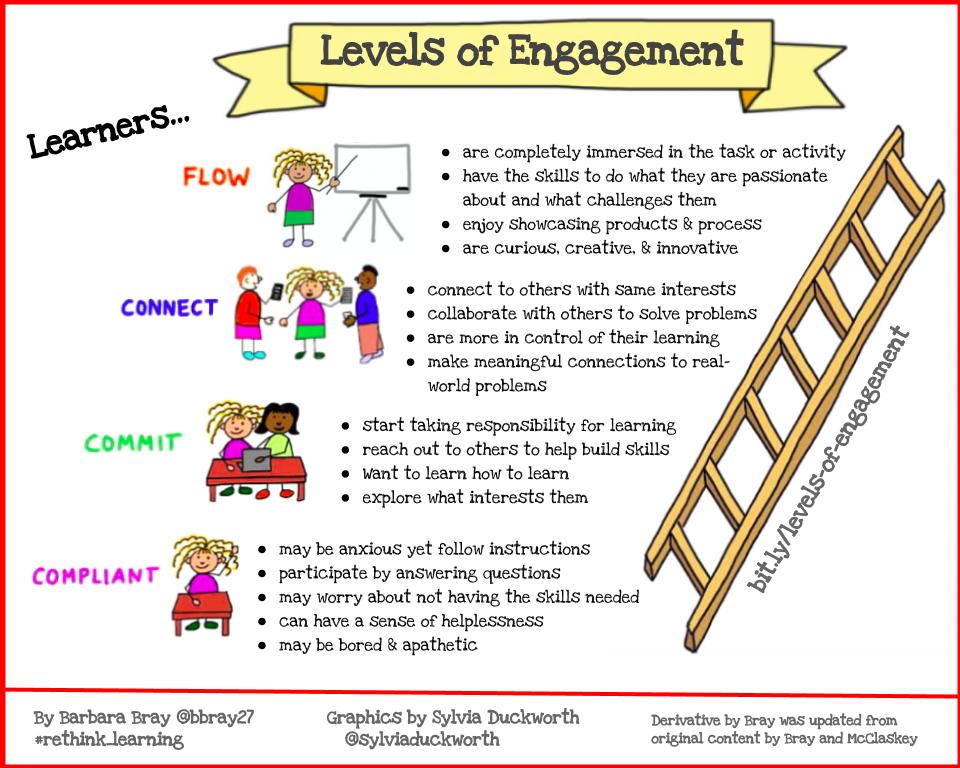
The Levels of Engagement design was created by Barbara Bray using some of the original content by Bray and Kathleen McClaskey with graphics by Sylvia Duckworth. Updated content and design is licensed under a Creative Commons Attribution-NonCommercial-NoDerivatives 4.0 International License
The original Continuum of Engagement focused on the teacher’s role in engaging students. After reading more about engagement with the “Flow” theory and the differences between engagement and empowerment, I believed it needed to be clearer that engagement is about how much any learner is engaged in a task or activity and the balance between the challenge before them and the skills they have to meet that challenge. Empowerment is what the learner or someone else can do to encourage engagement. The levels are more about how the learner is engaged in learning, not about the teacher or the learning environment. Yet, teachers are learners, too and they can create experiences and environments that are compassionate, creative and innovative. This idea of levels of engagement can pertain to any of us who are defining who we are as a learner.
Defining Engagement
Engagement is the affective side of learning and has been found to be a robust predictor of learner performance and behavior in the classroom. (Martin-Kniep, 2012) Engagement refers to the degree of attention, curiosity, interest, optimism, and passion that learners show when they are learning. So this may mean “engagement” is about how much we learn in the classroom or anywhere we learn. I needed to explore this more so checked out the 2016 Gallup Poll.
Measuring hope and engagement, the Gallup Student Poll helps educators gauge school success beyond test scores and grades. With nearly 5 million since 2009, the 2016 survey helps educators provide a more positive school culture — one that builds engagement, creates hope for the future, fosters talent and prepares students to meaningfully participate in the economy. Gallup Student Poll measures are linked to desirable learning outcomes, including self-reported grades, the perception of school success and self-reported absenteeism.
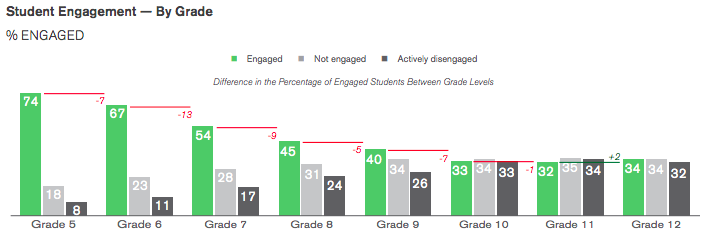
Download the 2016 snapshot report to learn more about how to empower hope and engagement in school. From the results, it is apparent in the Gallup Study that engagement decreased over the years in school. Yet, learning can happen anywhere and at any time especially now with content available at our fingertips. Some questions for you to consider when discussing engagement:
- Do we only measure learning that happens in a school?
- Are teachers or a school responsible for engaging the learners?
- Can teachers empower learners to want to be more engaged in learning?
- Have you noticed some learners more engaged than others?
- Could it be who the learners are that impacts their level of engagement?
- How does the environment impact the learning?
- What might keep some learners from being engaged in the learning process?
- How much does the system have to do with stopping curiosity, creativity, and engagement?
- What can we do to transform the system so learners are more curious, creative, and engaged in learning?
Flow Theory
When learners have a voice and choice in what and how they are learning especially if it is about something they are passionate about or interested in, they jump in and can get lost in the task or project. This is called “flow.” When learners are in the flow, you can notice, see and hear the engagement. Sometimes flow is quiet.
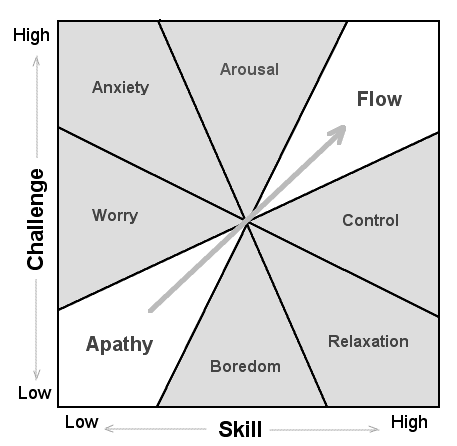
[Source: Adapted from Csikszentmihalyi, M. (1990). Flow:
The Psychology of Optimal Experience. New York: Harper and Row]
The Psychology of Optimal Experience. New York: Harper and Row]
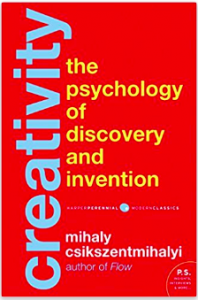 Mihaly Csikszentmihalyi is best known as the architect of the theory of flow. Flow is when a person is fully immersed in what they are doing and there is a balance between the challenge of the task and the skill of the learner. Flow cannot occur if the task is too easy or too difficult. Csíkszentmihályi published the graph above that depicts the relationship between the challenges of a task and skills. Flow only occurs when the activity is a higher-than-average challenge and requires above-average skills. Both skill level and challenge level must be matched and high; if skill and challenge are low and matched, then apathy results. (Csíkszentmihályi, 1990)
Mihaly Csikszentmihalyi is best known as the architect of the theory of flow. Flow is when a person is fully immersed in what they are doing and there is a balance between the challenge of the task and the skill of the learner. Flow cannot occur if the task is too easy or too difficult. Csíkszentmihályi published the graph above that depicts the relationship between the challenges of a task and skills. Flow only occurs when the activity is a higher-than-average challenge and requires above-average skills. Both skill level and challenge level must be matched and high; if skill and challenge are low and matched, then apathy results. (Csíkszentmihályi, 1990)
In Creativity: Flow and the Psychology of Invention and Discover (2013), Csíkszentmihályi explains why creativity is so fascinating that when we are involved in it, we feel that we are living more fully than during the rest of our lives. The examples and stories in the book help the reader understand how we change when we are immersed in an activity we are passionate about.
Levels of Engagement
Compliant
 In the Compliant level, learners may appear to be bored or anxious. Some may just give up on learning and follow whatever the teacher or school requires them to do. They may be good “students” who know how to “do” school. Their grades may be good but they are not empowered to do more than they have to do for a grade. There are others that have a fixed mindset and just give up because they were not empowered to learn or do not have a voice in what and how they learn. The school system might be focusing on test scores, worksheets, and homework that are probably not relevant or meaningful for the disengaged learner. The teacher may feel they are the only one responsible and accountable for all the learning in their classroom. Sometimes learners who are compliant have other issues at home that keep them from being engaged in learning.
In the Compliant level, learners may appear to be bored or anxious. Some may just give up on learning and follow whatever the teacher or school requires them to do. They may be good “students” who know how to “do” school. Their grades may be good but they are not empowered to do more than they have to do for a grade. There are others that have a fixed mindset and just give up because they were not empowered to learn or do not have a voice in what and how they learn. The school system might be focusing on test scores, worksheets, and homework that are probably not relevant or meaningful for the disengaged learner. The teacher may feel they are the only one responsible and accountable for all the learning in their classroom. Sometimes learners who are compliant have other issues at home that keep them from being engaged in learning.
Commit
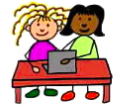 In the Commit level, learners are starting to take on more responsibility for their learning. The teacher is building the relationships with the learners by guiding the process for them to understand how they learn best. At this level, the teacher may still be laying the groundwork for learning and determining prior knowledge but learners may be demonstrating that they are more involved in what and how they learn. The commit level is where the learners find their voice to help become better learners. When they understand why they may be anxious about learning something, they discuss this with the teacher to help them through their anxiety. Learners are also reaching out to others to help them build the skills they will need to perform a task. They commit even more to want to learn when they have time to explore what interests them. This level is where learning is personal and the student finds out more about themselves and who they are as a learner. This is also the level where the teacher realizes that some children need more time or may have other issues keeping them from learning. The teacher-student relationship is so crucial at this level for all learners to help find their voice.
In the Commit level, learners are starting to take on more responsibility for their learning. The teacher is building the relationships with the learners by guiding the process for them to understand how they learn best. At this level, the teacher may still be laying the groundwork for learning and determining prior knowledge but learners may be demonstrating that they are more involved in what and how they learn. The commit level is where the learners find their voice to help become better learners. When they understand why they may be anxious about learning something, they discuss this with the teacher to help them through their anxiety. Learners are also reaching out to others to help them build the skills they will need to perform a task. They commit even more to want to learn when they have time to explore what interests them. This level is where learning is personal and the student finds out more about themselves and who they are as a learner. This is also the level where the teacher realizes that some children need more time or may have other issues keeping them from learning. The teacher-student relationship is so crucial at this level for all learners to help find their voice.
Connect
 In the Connect level, learners realize now that learning is social. They can expand on what they learned in the commit level by connecting with others who are at the same level or have the same interests. They are more in control of their learning but realize they can learn much more if they collaborate with others who can work together to build on their ideas. At this level, the learners are doing more of the talking than the teacher. This is where learners enjoy learning from each other and even teaching their peers. Learners are more engaged at this level when connected to real-world problems that are relevant to them. Today, learners connect with smart devices before and after school. Teachers and schools can make this level more effective if these smart devices are allowed during school hours. This is where “trust” and “letting go” of control can be so important. Our learners are using these devices and need to know the appropriate use so they can connect globally in an effective and safe way. This is the level where you notice it is getting a little noisier in some parts of the classroom.
In the Connect level, learners realize now that learning is social. They can expand on what they learned in the commit level by connecting with others who are at the same level or have the same interests. They are more in control of their learning but realize they can learn much more if they collaborate with others who can work together to build on their ideas. At this level, the learners are doing more of the talking than the teacher. This is where learners enjoy learning from each other and even teaching their peers. Learners are more engaged at this level when connected to real-world problems that are relevant to them. Today, learners connect with smart devices before and after school. Teachers and schools can make this level more effective if these smart devices are allowed during school hours. This is where “trust” and “letting go” of control can be so important. Our learners are using these devices and need to know the appropriate use so they can connect globally in an effective and safe way. This is the level where you notice it is getting a little noisier in some parts of the classroom.
Flow
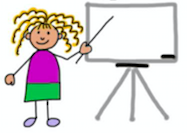 In the Flow level, many call it “messy learning” because it may seem chaotic to some people. Learners are curious, creative, and innovative. There is no one way to capture what it might look like. A few learners might be in the hall, another on a smartphone contacting a mentor, two sitting together animated on the floor in the back of the room, a small group brainstorming in the corner, and someone presenting evidence of learning to others for critical feedback. Some learners are working quietly immersed in the task at hand where others are reaching out to others to collaborate on solving a problem. This is when learners have the skills to pursue their interests and are curious by seeking what they are passionate about. They want to challenge themselves to investigate and solve solutions to real-world problems where they can make a difference. You can hear it in their voices and actions. They want to share what they learn. The teacher is more of a mentor and coach as they guide the process. This level is when learners self-advocate for what they need or want to learn and when they have agency.
In the Flow level, many call it “messy learning” because it may seem chaotic to some people. Learners are curious, creative, and innovative. There is no one way to capture what it might look like. A few learners might be in the hall, another on a smartphone contacting a mentor, two sitting together animated on the floor in the back of the room, a small group brainstorming in the corner, and someone presenting evidence of learning to others for critical feedback. Some learners are working quietly immersed in the task at hand where others are reaching out to others to collaborate on solving a problem. This is when learners have the skills to pursue their interests and are curious by seeking what they are passionate about. They want to challenge themselves to investigate and solve solutions to real-world problems where they can make a difference. You can hear it in their voices and actions. They want to share what they learn. The teacher is more of a mentor and coach as they guide the process. This level is when learners self-advocate for what they need or want to learn and when they have agency.
What I did notice about engagement is that sometimes we are in the flow because of the activity or task at hand. Other times we may not be engaged because of the activity. We may be at different levels at home or at school or in other learning environments. The engagement level can be high in a makerspace and low in a classroom depending on the activities.
Several teachers have said to me that when their kids are in the flow, “they never want to go back to the traditional way of teaching.” Some questions for you to think about and reflect on:
Have you experienced flow?
How much flow did you experience in school?
Where are you in the Levels of Engagement?
What about your learners in your classroom?
Do you notice different levels of engagement with different activities?
Thursday, December 5, 2019
5 Reasons to Personalize Learning
5 Reasons to Personalize Learning
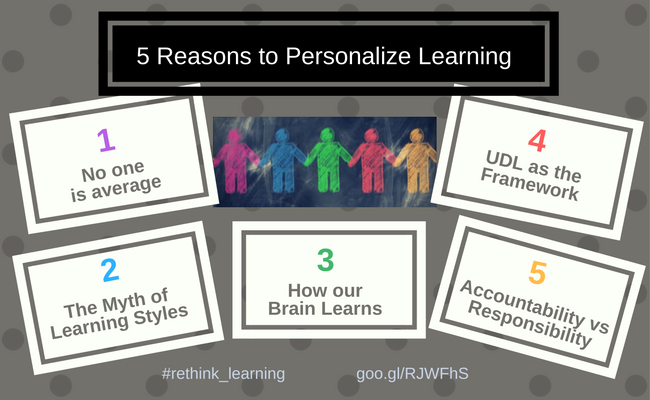
Personalizing learning means different things to different people. The idea I want to share behind personalized learning is to empower learners including you as a learner to own and drive learning. That’s not easy especially when teachers have so much on their plates. It could be easier to continue with the status quo. But the teachers I know want the best for all of their learners. This post is to provide a few reasons to consider when you personalize learning.
1. No one is average.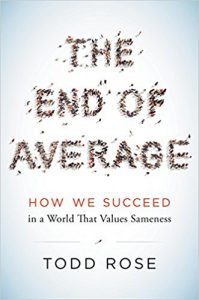
In Dr. Todd Rose’s book, The End of Average: How We Succeed in a World the Values Sameness, he explains why we came to embrace the scientifically flawed idea that averages can be used to understand individuals. Rose offers a powerful alternative with three principles of individuality: the jaggedness principle (talent is never one-dimensional), the context principle (traits are a myth), and the pathways principle (we all walk the road less traveled). He explains that we are all unique and can take full advantage of individuality to gain an edge in life.
So why is this one of my reasons to personalize learning? I believe each of us is unique and all of us are learners. When I read Dr. Rose’s book, he explained about variability and why education has to change to meet the needs of each individual learner.
“Why is there no average learner?”
2. The Myth of Learning Styles.
We are all unique as Dr. Rose mentioned in his book, End of Average. Because of who we are and how we all learn in different ways, learners have preferences about how they learn. According to the authors [Riener and Willingham, 2014], whether we call it talent, ability, or intelligence, people vary in their capacity to learn different areas of content, differ in their background knowledge, and, intertwined with ability, they differ in their interests. When we identify a learner as one learning style over another, it does not follow the research about how the brain works. We use all of the modalities because that is how our brain works.
So why is this one of my reasons to personalize learning? I’ve seen so many learners labeled visual or kinesthetic so teachers differentiated instruction based on one or two labels. All of us have multiple dimensions that make us who we are. Most of us are visual learners unless we cannot see. Even blind people visualize in their heads what they are seeing. I will be writing more about this, but I hope schools rethink why they should not use learning styles to label a child.
“Why are learning styles debunked?”
3. How our Brain Learns.
Learning is a neurobiological process indicated by the growth and strengthening of connections between neurons. The brain is constantly changing which is called neuroplasticity. This means the brain can be improved and continues to adapt and learn through life even into our old age. The human potential for learning is limitless at any age. When you learn something new, your brain makes new connections. Your brain is even active when you reflect on your learning. You learn when your brain is active especially when learners ask questions, investigate, create, or reflect on their learning. Passive exposure or listening to a lecture does not necessarily lead to learning.
So why is this one of my reasons to personalize learning? Our brain is constantly changing as we learn. When a school or parent believes that a child is born with certain traits or talents, this can cause the child to believe that’s all they are. This happened to me. I was told I wasn’t very smart. I believed that during most of my school. My parents always believed in me and fought for me. And, on my own, I read and was hungry to learn. So I did. I was lucky to have parents who believed in me and a teacher who believed in my writing. I finally realized that I could learn anything if I put my mind to it. So now I write, share, and learn something new every day. I know that every child can learn because their brain is growing and learning every day. All children can learn if we give them opportunities and the support they need.
“How does the brain work?”
4. Universal Design for Learning® as the Framework
David Rose and Ann Meyers from The Center for Applied Special Technology (CAST) founded Universal Design for Learning® (UDL) based on decades of brain research and the neuroscience of individual differences, human variability, and how we learn. UDL is about reducing or eliminating the barriers to learning and optimizing levels of support to meet the needs and interests of all learners in the classroom. They realized that the curriculum, not the learner, was the problem. UDL provides a blueprint for creating instructional methods, materials, and assessments that can be customized and adjusted for individual needs.
So why is this one of my reasons to personalize learning? We need to put more energy into finding out how children learn best. Universal Design for Learning does that. The three principles, Multiple Means of Engagement, Multiple Means of Representation, and Multiple Means of Action and Expression, pave the way. All three of the principles work together, but when you start with the “Why” of what engages you to want to learn, nothing can stop you. It is about encouraging curiosity and wonder. That passion to learn is what is so exciting about personalized learning.
“How can we reduce barriers to learning?”
5. Accountability vs. Responsibility
The word “responsibility” tends to be interchangeable with the word “accountability.” In many cases, teachers feel they are the ones responsible for students to learn. The reason is that the system seems to hold them and the school accountable for what students learn. “Accountability” refers to making, keeping, and managing agreements and expectations where “responsibility” is the feeling of ownership. So this means that each learner needs to be held accountable for what they learn by taking responsibility for their own learning.
So why is this one of my reasons to personalize learning? If the teacher is the hardest person working in the classroom, then who are the people really learning? Learning is not about passively receiving information. When the teacher is the one held accountable for what kids learn, then learning becomes work, not fun for both the teacher and learners. When our kids have a voice and choice in what and how they learn, they want to learn. They are motivated to learn. When they realize learning is for them not for a grade or for the teacher, they own it and develop agency.
“Who owns the learning?”
****
All learners can learn. It is our job as educators to provide the environment and support system so learners have a voice and choice in their learning. These are just a few reasons for you to consider if you go on the journey to personalize learning for all of your learners. Barbara Bray.
Tuesday, November 19, 2019
Differentiated, Individualized, and Personalized Learning - The Likenesses and Differences
West Valley Team - Our move toward providing a more student-centered, personalized learning environment for our students has prompted many discussions around the use of the words, differentiated, individualized, and personalized. This morning, I came across an article that tries to make sense of the use of these three words;
While Differentiated, Individualized, and Personalized Learning are Distinct, They Also Overlap
Classrooms are a whirlwind of learning styles, needs, interests, backgrounds, and abilities. Students need to not only be met where they are but also have a say in where they’re going. Fortunately, educators have access to a plethora of instructional approaches that, if implemented effectively, will provide students with the high level of engaged learning they require to be successful.
But unfortunately, over the years, the purpose and distinguishing characteristics of some of these instructional approaches has become unclear. Let’s detangle some of the loose edges surrounding differentiated, individualized, and personalized learning—three instructional approaches that are constantly confused.
By understanding the difference, and ultimately how these separate strategies can fit together, you will be better equipped to initiate more engaging and effective learning, and ultimately shift to a student-centered approach.
What is Differentiated Learning?
Differentiated learning is instruction tailored to the learning needs and preferences of different students. It’s a step in the direction away from the “one-size-fits-all” approach to teaching. The method varies according to the needs of each student or what research and real-time observation shows works best for similar students in groups, but learning goals remain the same for everyone.
What is Individualized Learning?
Similar to differentiation, individualized learning is instruction based on the learning needs of students. Individualization, however, places more focus on student pacing.
What is Personalized Learning?
Of the three strategies discussed in this article, personalized learning provides the most student autonomy. Students have an active role in designing lessons and projects that are meaningful and relevant to them based on their interests, aspirations, and passions. Teachers, then, act more as guides than the curators of information and learning experiences.
Seeing Beyond the Differences
Now that you understand the clear distinctions between each of these strategies, I want to challenge you to ignore the lines between them. While it’s important to recognize what you’re practicing, where the ideas come from, and what the research says about their effectiveness, these strategies all have elements that can help create powerful, student-centered learning experiences, whether you use them individually or combine them together.
So whether you’re differentiating learning, individualizing learning, personalizing learning, or combining elements of all three, remember that it’s not about conforming to the strategy as much as it’s about conforming the strategy to your students’ needs.
While Differentiated, Individualized, and Personalized Learning are Distinct, They Also Overlap
Classrooms are a whirlwind of learning styles, needs, interests, backgrounds, and abilities. Students need to not only be met where they are but also have a say in where they’re going. Fortunately, educators have access to a plethora of instructional approaches that, if implemented effectively, will provide students with the high level of engaged learning they require to be successful.
But unfortunately, over the years, the purpose and distinguishing characteristics of some of these instructional approaches has become unclear. Let’s detangle some of the loose edges surrounding differentiated, individualized, and personalized learning—three instructional approaches that are constantly confused.
By understanding the difference, and ultimately how these separate strategies can fit together, you will be better equipped to initiate more engaging and effective learning, and ultimately shift to a student-centered approach.
What is Differentiated Learning?
Differentiated learning is instruction tailored to the learning needs and preferences of different students. It’s a step in the direction away from the “one-size-fits-all” approach to teaching. The method varies according to the needs of each student or what research and real-time observation shows works best for similar students in groups, but learning goals remain the same for everyone.
What is Individualized Learning?
Similar to differentiation, individualized learning is instruction based on the learning needs of students. Individualization, however, places more focus on student pacing.
What is Personalized Learning?
Of the three strategies discussed in this article, personalized learning provides the most student autonomy. Students have an active role in designing lessons and projects that are meaningful and relevant to them based on their interests, aspirations, and passions. Teachers, then, act more as guides than the curators of information and learning experiences.
Seeing Beyond the Differences
Now that you understand the clear distinctions between each of these strategies, I want to challenge you to ignore the lines between them. While it’s important to recognize what you’re practicing, where the ideas come from, and what the research says about their effectiveness, these strategies all have elements that can help create powerful, student-centered learning experiences, whether you use them individually or combine them together.
So whether you’re differentiating learning, individualizing learning, personalizing learning, or combining elements of all three, remember that it’s not about conforming to the strategy as much as it’s about conforming the strategy to your students’ needs.
Monday, September 30, 2019
Summary of AASA Personalized Learning Cohort Meetings and Focus
Kristin Humphries, Superintendent for the East Moline School
District
Blog entry for AASA
09.30.19
Dr. Maya Angelou said, “Do the best you can until you know
better. Then when you know better, do better.” After participating in AASA’s
Personalized Learning Cohort for the past two years, I know better. AASA’s
Personalized Learning Cohort is a group of superintendents and district leaders
who have come together around a problem of practice. How do we move schools
that were built around an industrial model into a new world economy and
personalize education for each and every child in order to reach their full
potential?
For the past two years, I have seen incredible work in the
field by our colleagues and their school districts as they move to a model that
is tailored to meet the unique needs of every child. In the Dysart Unified
School District in Surprise, Arizona, we saw scaffolded, personalized
instruction starting in kindergarten. In North Penn, just outside Philadelphia,
we were able to see students in charge of their learning and interacting with
standards by creating content in high-interest areas to spark engagement. Just
last week, we visited the Mehlville School District in St. Louis to see their
work in helping all children create and navigate pathways that were personalized
to their specific needs. As my colleague and Personalized Learning Cohort
member Dr. Jeff Thake, superintendent for the Williston, North Dakota Schools,
said, “When we really dig deep to answer the question -- how does each student
learn best and what is each student’s strengths and interests, it’s going to
transform public education as we know it.”
In the East Moline School District, we have been hard at
work for over five years to move to standards-based, student-centered
instruction at a rigorous level. It’s been a great deal of work, but our
teachers are seeing the fruits of their labor in students that are more in
charge of their own learning. As superintendent, it is important for me to communicate
our shared vision that every child in the East Moline School District deserves
a world-class education that is tailored to their specific needs. Dr. Gail
Pletnick, retired superintendent of the Dysart Unified School District and
co-chair of the Personalized Learning Cohort said, “This mission that we are
all on, to personalize learning, is about equity.” The parents in my school
district dream of infinite possibilities for their children just like parents
from Dysart, North Penn and Mehlville. The Personalized Learning Cohort has
helped me envision those next steps in East Moline as I learn from
superintendents and school districts that have worked to create individualized
pathways for their students in order to meet their full potential.
I look forward to continuing the work of our Personalized
Learning Cohort. We are focused on learner agency by increasing engagement and
giving students choice and voice as they take ownership of their education. I
hope more superintendents get involved in this important work as we grow and
learn together in personalizing education for every child. When we know better,
we do better.
Subscribe to:
Comments (Atom)



